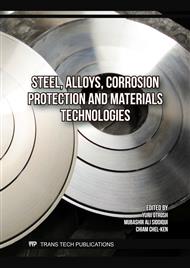[1]
J. Ding, D. Wang and Wang Ying, "Effect of Post weld heat treatment on properties of variable polarity TIG welded AA 2219 Aluminium joints," Transaction of Nonferrous Metal society of china, 2014.
DOI: 10.1016/s1003-6326(14)63193-9
Google Scholar
[2]
P. C.S. and B. R.G., "Microstructure, microchemistry and environmental cracking susceptibility of friction stir welded 2219-T87," Materials Science and Engineering: A, 2006.
DOI: 10.1016/j.msea.2006.05.036
Google Scholar
[3]
R. G. Venkat and S. Narsimhulu, "Evaluation of tensile and microstructure properties of AA2014 and AA7075 FSW weldments developed by HSS-10%Co and WC tools," Materialstoday: proceedings Volume 46, Part 1, 2021.
DOI: 10.1016/j.matpr.2021.01.060
Google Scholar
[4]
Sambasivam, S., Gupta, N., Singh, D. P., Kumar, S., Giri, J. M., & Gupta, M. (2023). A review paper of FSW on dissimilar materials using aluminum. Materials Today: Proceedings.
DOI: 10.1016/j.matpr.2023.03.304
Google Scholar
[5]
B. Guido Di, F. Federica and B. Chiara, "Effect of Process Parameters on Friction Stir Welded Joints between Dissimilar Aluminum Alloys: A Review," Metals, 2023.
DOI: 10.3390/met13071176
Google Scholar
[6]
Boopathi, S., Kumaresan, A., Manohar, N., & Moorthi, R. K. (2017). Review on effect of process parameters-friction stir welding process. International Research Journal of Engineering and Technology (IRJET), 4(7).
Google Scholar
[7]
Mohamed, M. Z.Ahmed, M. E.-S. Seleman, D. Fydrych and G. Çam, "Friction Stir Welding of Aluminum in the Aerospace Industry: The Current Progress and State-of-the-Art Review," Materials, 2023.
DOI: 10.3390/ma16082971
Google Scholar
[8]
J. Torzewski, M. Łazińska and K. Grzelak, "Microstructure and Mechanical Properties of Dissimilar Friction Stir Welded Joint AA7020/AA5083 with Different Joining Parameters," Materials, 2022.
DOI: 10.3390/ma15051910
Google Scholar
[9]
M.Cabibbo, A.Forcellese, E. Santecchia and E. C. Paoletti, "New Approaches to Friction Stir Welding of Aluminium Light-Alloys," Metals, 2020.
DOI: 10.3390/met10020233
Google Scholar
[10]
S. Chatterjee and S. Chakraborty, "Optimization of friction stir welding processes using multi-attributive border approximation area comparison (MABAC) method in neutrosophic fuzzy environment," International Journal on Interactive Design and Manufacturing (IJIDeM), 2023.
DOI: 10.1007/s12008-023-01308-6
Google Scholar
[11]
A. Heidarzadeh and H. Khodaverdizadeh, "Tensile behavior of friction stir welded AA 6061-T4 aluminum," Material Design, 2012.
DOI: 10.1016/j.matdes.2011.12.022
Google Scholar
[12]
K. Elangovan, V. Balasubramanian and b. Babu, "Predicting tensile strength of friction stir welded AA6061 aluminium alloy joints by a mathematical model," Materials & Design, 2009.
DOI: 10.1016/j.matdes.2008.04.037
Google Scholar
[13]
G. Ipekoglu, S. Erim and G. Çam, "Investigation into the Influence of Post-Weld Heat Treatment on the Friction Stir Welded AA6061 Al-Alloy Plates with Different Temper Conditions," Metallurgical and Materials Transactions A, 2014.
DOI: 10.1007/s11661-013-2026-y
Google Scholar
[14]
M. Muzamil, J. Wu, M. Akhtar, K. Azher, A. Majeed, Z. Zhang, and A. Shazad, "Nanoparticle-induced control (MWCNTs–TiO₂) on grain size and tensile strength response and multi-response optimization on TIG welded joints," Transactions of the Canadian Society for Mechanical Engineering, vol. 46, no. 3, p.626–638, 2022.
DOI: 10.1139/tcsme-2021-0210
Google Scholar
[15]
K. Elangovan and. V. Balasubramanian, "Influences of post-weld heat treatment on tensile properties of friction stir-welded AA6061 aluminum alloy joints," Materials Characterization, 2008.
DOI: 10.1016/j.matchar.2007.09.006
Google Scholar
[16]
A. Shazad, M. Uzair, and M. Tufail, "Influence of multiple post weld repairs on mechanical and microstructural properties of butt weld joint utilized in structural members," International Journal of Precision Engineering and Manufacturing, vol. 26, no. 1, p.157–164, 2025.
DOI: 10.1007/s12541-024-01104-6
Google Scholar
[17]
R. Priya,, V. S. Sarma and . K. P. Rao , "Effect of post weld heat treatment on the microstructure and tensile properties of dissimilar friction stir welded AA 2219 and AA 6061 alloys," Transactions of the Indian Institute of Metals, 2009.
DOI: 10.1007/s12666-009-0002-4
Google Scholar
[18]
A. Shazad, M. Uzair, T. Jamil, and N. Muhammad, "A comparative study on the joint hardness and tensile properties of dissimilar aluminum alloy using Tungsten Inert Gas (TIG) welding," Proceedings of the 4th International Conference on Key Enabling Technologies (KEYTECH 2024), p.173–178, Atlantis Press, Dec. 2024.
DOI: 10.2991/978-94-6463-602-4_25
Google Scholar
[19]
M. M. Moradi,, H. J. Aval and R. Jamaati, "Effect of pre and post welding heat treatment in SiC-fortified dissimilar AA6061-AA2024 FSW butt joint," Journal of Manufacturing Processes, 2017.
DOI: 10.1016/j.jmapro.2017.08.014
Google Scholar
[20]
A. Shazad, M. Astif, M. Uzair, and A. A. Zaidi, "Evaluation of preheating impact on weld residual stresses in AH-36 steel using finite element analysis," Memoria Investigaciones en Ingeniería, no. 26, p.225–243, 2024.
DOI: 10.36561/ing.26.14
Google Scholar
[21]
Han, W. H., Li, P., Liu, N., Chen, C. G., Dong, S. P., Guo, Z. M., ... & Volinsky, A. A. (2022). Microstructure and mechanical properties of friction stir welded powder metallurgy AA2024 alloy. Journal of Central South University, 29(3), 871-882.
DOI: 10.1007/s11771-022-4962-4
Google Scholar
[22]
T. Morishige, A. Kawaguchi, M. Tsujikawa, M. Hino, T. Hirata, and K. Higashi, "Dissimilar welding of Al and Mg alloys by FSW," Materials Transactions, vol. 49, no. 5, p.1129–1131, 2008.
DOI: 10.2320/matertrans.mc200768
Google Scholar
[23]
G. Chu, L. Sun and C. Lin, "Effect of Local Post Weld Heat Treatment on Tensile Properties in Friction Stir Welded 2219-O Al Alloy," Journal of Materials Engineering and Performance, 2017.
DOI: 10.1007/s11665-017-2998-7
Google Scholar


